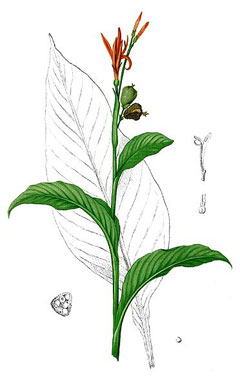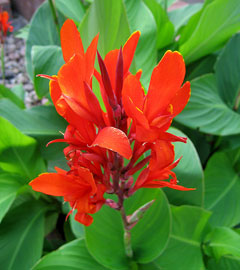 |
|
http://commons.wikimedia.org/wiki/File:Canna_indica_Blanco1.4-cropped.jpg |
 |
| http://commons.wikimedia.org/wiki/User:Arz |
Translate this page:
Summary
Physical Characteristics

 Canna_indica is a PERENNIAL growing to 1.5 m (5ft) by 0.6 m (2ft in).
Canna_indica is a PERENNIAL growing to 1.5 m (5ft) by 0.6 m (2ft in).
See above for USDA hardiness. It is hardy to UK zone 8 and is frost tender. It is in flower from August to October, and the seeds ripen in October. The species is hermaphrodite (has both male and female organs).
Suitable for: light (sandy), medium (loamy) and heavy (clay) soils and prefers well-drained soil. Suitable pH: mildly acid, neutral and basic (mildly alkaline) soils. It cannot grow in the shade. It prefers moist soil.
UK Hardiness Map
US Hardiness Map
Synonyms
Plant Habitats
Edible Uses
Root - cooked. The source of 'canna starch', used as an arrowroot[97, 177]. The arrowroot is obtained by rasping the root to a pulp, then washing and straining to get rid of the fibres[2]. The very young tubers are eaten cooked, they are sweet but fibrousy[97, K]. Roots contain about 25% starch[61]. There is one report that this plant has an edible fruit[177] but this is somewhat dubious, the fruit is a dry capsule containing the very hard seeds[K].
References More on Edible Uses
Medicinal Uses
Plants For A Future can not take any responsibility for any adverse effects from the use of plants. Always seek advice from a professional before using a plant medicinally.
The plant is used in the treatment of women's complaints[218]. A decoction of the root with fermented rice is used in the treatment of gonorrhoea and amenorrhoea[218]. The plant is also considered to be demulcent, diaphoretic and diuretic[218].
References More on Medicinal Uses
The Bookshop: Edible Plant Books
Our Latest books on Perennial Plants For Food Forests and Permaculture Gardens in paperback or digital formats.

Edible Tropical Plants
Food Forest Plants for Hotter Conditions: 250+ Plants For Tropical Food Forests & Permaculture Gardens.
More

Edible Temperate Plants
Plants for Your Food Forest: 500 Plants for Temperate Food Forests & Permaculture Gardens.
More

More Books
PFAF have eight books available in paperback and digital formats. Browse the shop for more information.
Shop Now
Other Uses
The plant yields a fibre - from the stem? - it is a jute substitute[114]. A fibre obtained from the leaves is used for making paper[189]. The leaves are harvested in late summer after the plant has flowered, they are scraped to remove the outer skin and are then soaked in water for 2 hours prior to cooking. The fibres are cooked for 24 hours with lye and then beaten in a blender. They make a light tan brown paper[189]. A purple dye is obtained from the seed[114]. Smoke from the burning leaves is said to be insecticidal[218].
Special Uses
References More on Other Uses
Cultivation details
Requires a deep rich well-drained soil in a sunny position[200]. The plant has large leaves and dislikes windy conditions since this can tear the leaves to shreds[200]. This species is probably hardy in the mildest areas of Britain but even then it should be given a good mulch if left in the ground overwinter[1, 200]. Plants have survived temperatures down to about -5°c overwinter with us[K]. This species is often grown as a summer bedding plant in Britain, especially in sub-tropical bedding schemes. In colder areas of the country the tubers can be harvested in late autumn after the top growth has been killed back by frost and stored over winter. They should be kept in a cool but frost-free place covered in moist soil or leaves[1]. Plants are cultivated for their edible root in the Tropics. Slugs love the young growth in spring and can cause serious damage to plants[233].
References Carbon Farming Information and Carbon Sequestration Information
Temperature Converter
Type a value in the Celsius field to convert the value to Fahrenheit:
Fahrenheit:
The PFAF Bookshop
Plants For A Future have a number of books available in paperback and digital form. Book titles include Edible Plants, Edible Perennials, Edible Trees,Edible Shrubs, Woodland Gardening, and Temperate Food Forest Plants. Our new book is Food Forest Plants For Hotter Conditions (Tropical and Sub-Tropical).
Shop Now
Plant Propagation
Seed - pre-soak for 24 hours in warm water and sow February/March in a warm greenhouse at 20°c[1, 138]. Plant the seeds 2 - 5cm deep in individual pots[1]. Scarifying the seed can speed germination, especially if the seed has not swollen after being soaked[124, K]. The seed usually germinates in 3 - 9 weeks[138]. Grow the plants on in a greenhouse for at least their first winter. Plant them out into their permanent positions in late spring or early summer, after the last expected frosts. Division of the root clump as the plant comes into growth in the spring. Each portion must have at least one growing point. Pot up the divisions and grow them on in the greenhouse until they are well established and then plant them out in the summer. Root cuttings.
Other Names
If available other names are mentioned here
Native Range
NORTHERN AMERICA: Mexico (Tamaulipas, Campeche, Chiapas, Hidalgo, Jalisco, Michoacán de Ocampo, Nayarit, Puebla, Quintana Roo, Tabasco, Veracruz de Ignacio de la Llave, Yucatán) SOUTHERN AMERICA: Netherlands Antilles, Antigua and Barbuda, Barbados, Cuba, Dominica, Dominican Republic, Guadeloupe, Grenada, Haiti, Jamaica, St. Kitts and Nevis, Martinique, United States (Puerto Rico), St. Vincent and Grenadines, Belize, Costa Rica, Guatemala, Honduras, Nicaragua, Panama, El Salvador, French Guiana, Guyana, Suriname, Venezuela, Brazil, Bolivia, Colombia, Ecuador, Peru, Argentina (Buenos Aires, Chaco, Corrientes, Entre Ríos, Formosa, Jujuy, Misiones, Salta, Tucumán), Paraguay, Uruguay
Weed Potential
Right plant wrong place. We are currently updating this section.
Please note that a plant may be invasive in one area but may not in your area so it's worth checking.
Conservation Status
IUCN Red List of Threatened Plants Status :

Growth: S = slow M = medium F = fast. Soil: L = light (sandy) M = medium H = heavy (clay). pH: A = acid N = neutral B = basic (alkaline). Shade: F = full shade S = semi-shade N = no shade. Moisture: D = dry M = Moist We = wet Wa = water.
Now available:
Food Forest Plants for Mediterranean Conditions
350+ Perennial Plants For Mediterranean and Drier Food Forests and Permaculture Gardens.
[Paperback and eBook]
This is the third in Plants For A Future's series of plant guides for food forests tailored to
specific climate zones. Following volumes on temperate and tropical ecosystems, this book focuses
on species suited to Mediterranean conditions—regions with hot, dry summers and cool, wet winters,
often facing the added challenge of climate change.
Read More
Expert comment
Author
L.
Botanical References
50200
Links / References
For a list of references used on this page please go here
Readers comment